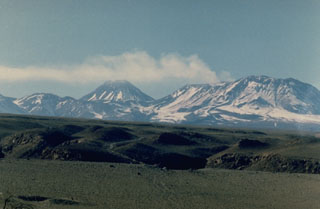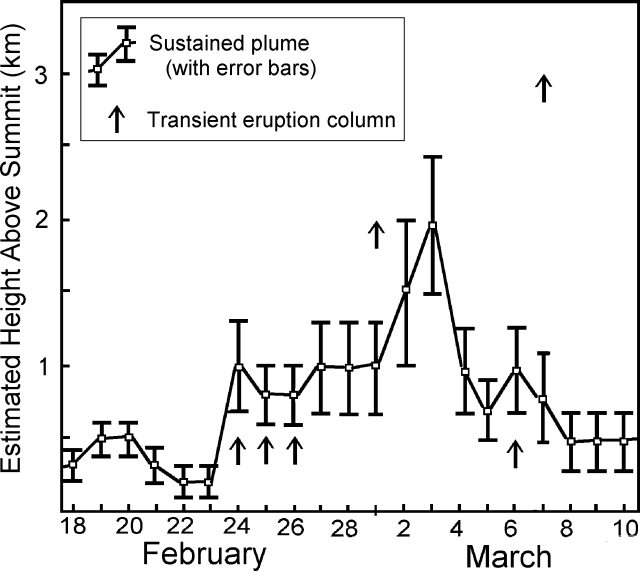Report on Lascar (Chile) — March 1995
Bulletin of the Global Volcanism Network, vol. 20, no. 3 (March 1995)
Managing Editor: Richard Wunderman.
Lascar (Chile) Small ash eruptions and increased height of gas plume
Please cite this report as:
Global Volcanism Program, 1995. Report on Lascar (Chile) (Wunderman, R., ed.). Bulletin of the Global Volcanism Network, 20:3. Smithsonian Institution. https://doi.org/10.5479/si.GVP.BGVN199503-355100
Lascar
Chile
23.37°S, 67.73°W; summit elev. 5592 m
All times are local (unless otherwise noted)
Activity in February-March 1995. For the period 18 February to 10 March 1995 Lascar remained fairly active—frequently changing the altitude of its gas plume, producing small ash eruptions, and ejecting dense columns of water vapor (figure 24). The plume, which was typically pulsing, had a yellowish or brownish color. On 23 and 25 February underground booming noises ('retumbos') were heard 4 km from the volcano on both the N and NW flanks and at the village of Soncor, 25 km SW. On 24 February the plume's height above the crater suddenly increased from 200 m to 1,000 m (figure 24). This elevated "sustained" plume height marked the beginning of a series of small eruptions whose "transient" column heights are depicted by the arrow tips on figure 24. The sustained plume height initially remained comparatively high, reaching a maximum of 2 km above the volcano on 3 March; later, sustained plume height decreased gradually to ~500 m (figure 24).
At 0800 on 26 February a small ash-bearing eruption was reported by the Carabineros from 35 km NW of the volcano in Toconao. A black column rose at least 200 m (probably higher) above the crater. Retumbos associated with this eruption were audible at the offices of MINSAL in Toconao. Three larger eruptions were observed on 7 March, between 0000 and 0100, by Elcira Araya at the MINSAL offices. In each case a dark column rose an estimated 3 km above the crater. Plumes from these columns blew NW over Toconao and many residents reported a strong sulfur smell. The type of activity described (retumbos and small ash-rich eruptions) has in the past preceded larger Vulcanian eruptions. It is thought likely that such a Vulcanian eruption will occur in the near future.
Recent crater collapse and eruptive activity. At least two eruptive events took place in late 1994, both producing columns 4-km high. In November, Luis Aracena, a tour guide from San Pedro de Atacama, climbed Lascar and noted that a portion of the S rim had collapsed into the crater. Fractures on the S side of the crater had enlarged with an increase in fumarolic activity. He also found that the central hole in the crater floor had deepened substantially. One of his photos revealed large new arcuate fractures along the base of the talus slope at the foot of the NE crater wall.
Volcanologists concluded that the crater floor had continued to subside, destabilizing the walls and inducing them to collapse. The crater is thus becoming deeper and wider. In addition, blockage of the gas jets in the base of the crater due to subsidence on ring fractures and rockfalls from the walls has led to periodic 'throat clearing' eruptions. The edifice was expected to become increasingly unstable so long as this activity continues. Thus, the Carabineros in Toconao began advising tourists not to climb the volcano due to the high risk of both small explosive eruptions and of additional collapse along the S rim (along the favored ascent route).
Geological Summary. Láscar is the most active volcano of the northern Chilean Andes. The andesitic-to-dacitic stratovolcano contains six overlapping summit craters. Prominent lava flows descend its NW flanks. An older, higher stratovolcano 5 km E, Volcán Aguas Calientes, displays a well-developed summit crater and a probable Holocene lava flow near its summit (de Silva and Francis, 1991). Láscar consists of two major edifices; activity began at the eastern volcano and then shifted to the western cone. The largest eruption took place about 26,500 years ago, and following the eruption of the Tumbres scoria flow about 9000 years ago, activity shifted back to the eastern edifice, where three overlapping craters were formed. Frequent small-to-moderate explosive eruptions have been recorded since the mid-19th century, along with periodic larger eruptions that produced ashfall hundreds of kilometers away. The largest historical eruption took place in 1993, producing pyroclastic flows to 8.5 km NW of the summit and ashfall in Buenos Aires.
Information Contacts: S. Matthews, Univ of Bristol; M. Gardeweg, SERNAGEOMIN, Santiago.


